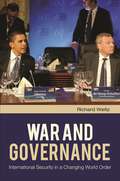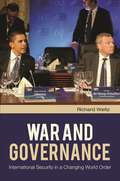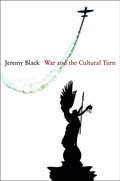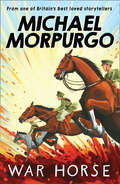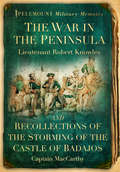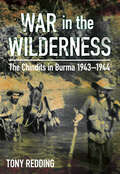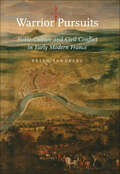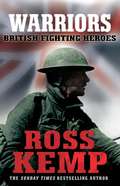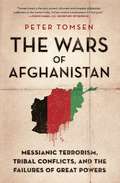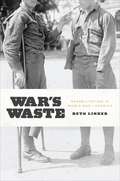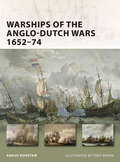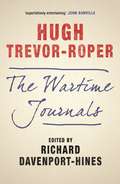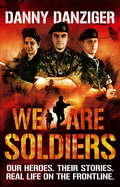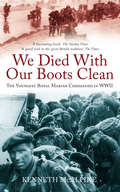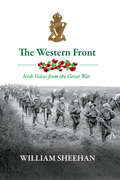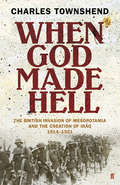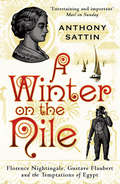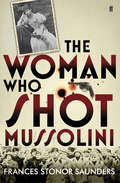- Table View
- List View
War and Governance: International Security in a Changing World Order (The Changing Face of War)
by Richard WeitzAn insightful and expert assessment examines how best to end—and avert—wars.How do we avoid war? To arrive at an answer, master analyst Richard Weitz explores the ways nations, international organizations, and individuals have sought to bring order to an inherently disorderly phenomenon—potential and actual violent conflict among organized political entities. Specifically, War and Governance: International Security in a Changing World Order analyzes a number of critical issues such as whether regional security institutions have distinct advantages and liabilities in promoting international security, as compared with universal organizations like the United Nations. Other important questions are addressed, as well. How will international organizations, such as the UN, EU, and NATO, change the nature of war in the 21st century—and be changed by it? What role might less formal institutions and nongovernmental organizations play in peacemaking? Will the nation-state remain the most important international security actor? The book ends with a gap analysis that identifies incongruities between international needs and capabilities—and suggests ways to overcome them.
War and Governance: International Security in a Changing World Order (The Changing Face of War)
by Richard WeitzAn insightful and expert assessment examines how best to end—and avert—wars.How do we avoid war? To arrive at an answer, master analyst Richard Weitz explores the ways nations, international organizations, and individuals have sought to bring order to an inherently disorderly phenomenon—potential and actual violent conflict among organized political entities. Specifically, War and Governance: International Security in a Changing World Order analyzes a number of critical issues such as whether regional security institutions have distinct advantages and liabilities in promoting international security, as compared with universal organizations like the United Nations. Other important questions are addressed, as well. How will international organizations, such as the UN, EU, and NATO, change the nature of war in the 21st century—and be changed by it? What role might less formal institutions and nongovernmental organizations play in peacemaking? Will the nation-state remain the most important international security actor? The book ends with a gap analysis that identifies incongruities between international needs and capabilities—and suggests ways to overcome them.
War and the Cultural Turn
by Jeremy BlackIn this stimulating new text, renowned military historian Jeremy Black unpacks the concept of culture as a descriptive and analytical approach to the history of warfare. Black takes the reader through the limits and prospects of culture as a tool for analyzing war, while also demonstrating the necessity of maintaining the context of alternative analytical matrices, such as technology. Black sets out his unique approach to culture and warfare without making his paradigm into a straightjacket. He goes on to demonstrate the flexibility of his argument through a series of case studies which include the contexts of rationale (Gloire), strategy (early modern Britaisn), organizations (the modern West), and ideologies (the Cold War). These case studies drive home the point at the core of the book: culture is not a bumper sticker; it is a survival mechanism. Culture is not immutable; it is adaptable. Wide-ranging, international and always provocative, War and the Cultural Turn will be required reading for all students of military history and security studies.
War and the Cultural Turn
by Jeremy BlackIn this stimulating new text, renowned military historian Jeremy Black unpacks the concept of culture as a descriptive and analytical approach to the history of warfare. Black takes the reader through the limits and prospects of culture as a tool for analyzing war, while also demonstrating the necessity of maintaining the context of alternative analytical matrices, such as technology. Black sets out his unique approach to culture and warfare without making his paradigm into a straightjacket. He goes on to demonstrate the flexibility of his argument through a series of case studies which include the contexts of rationale (Gloire), strategy (early modern Britaisn), organizations (the modern West), and ideologies (the Cold War). These case studies drive home the point at the core of the book: culture is not a bumper sticker; it is a survival mechanism. Culture is not immutable; it is adaptable. Wide-ranging, international and always provocative, War and the Cultural Turn will be required reading for all students of military history and security studies.
War Horse (Oxford Playscripts Ser.)
by Michael MorpurgoBefore the Steven Spielberg film, before the National Theatre production, there was the classic children’s novel…
The War in the Peninsula and Recollections of the Storming of the Castle of Badajos
by Lieutenant Robert Knowles Captain James MacCarthyLieutenant Knowles served in the 7th (Royal) Fusiliers 1811-1813, seeing action in several battles, being wounded at the storming of Badajoz and at the battle of Salamanca. He was killed at Roncesvalles on 25 July 1813 during the Battle of the Pyrenees. By combining the overall picture as painted by Lt Knowles with the specific, bloody narrative of the storming of the Castle by Captain MacCarthy in one volume, this work is not only fantastic value for money but also offers the discerning reader a whole new perspective on the campaign. What did these two men – of different temperaments – make of events? Wellington had watched helplessly at Badajos as the flower of his army was smashed against the ramparts of Badajos: the 4th and Light Divisions attacked no less than 40 times. When they finally succeeded, an orgy of rape, pillage and destruction followed that even the Iron Duke could not quell. What did both men have to say about this? Both of these rare classics are essential reading for students of the period
War in the Wilderness: The Chindits in Burma 1943-1944
by Tony ReddingWar in the Wilderness is the most comprehensive account ever published of the human aspects of the Chindit war in Burma. The word ‘Chindit’ will always have a special resonance in military circles. Every Chindit endured what is widely regarded as the toughest sustained Allied combat experience of the Second World War. The Chindit expeditions behind Japanese lines in occupied Burma 1943–1944 transformed the morale of British forces after the crushing defeats of 1942. The Chindits provided the springboard for the Allies’ later offensives. The two expeditions extended the boundaries of human endurance. The Chindits suffered slow starvation and exposure to dysentery, malaria, typhus and a catalogue of other diseases. They endured the intense mental strain of living and fighting under the jungle canopy, with the ever-present threat of ambush or simply ‘bumping’ the enemy. Every Chindit carried his kit and weapons (equivalent to two heavy suitcases) in the tropical heat and humidity. A disabling wound or sickness frequently meant a lonely death. Those who could no longer march were often left behind with virtually no hope of survival. Some severely wounded were shot or given a lethal dose of morphia to ensure they would not be captured alive by the Japanese. Fifty veterans of the Chindit expeditions kindly gave interviews for this book. Many remarked on the self-reliance that sprang from living and fighting as a Chindit. Whatever happened to them after their experiences in Burma, they knew that nothing else would ever be as bad. There are first-hand accounts of the bitter and costly battles and the final, wasteful weeks, when men were forced to continue fighting long after their health and strength had collapsed. War in the Wilderness continues the story as the survivors returned to civilian life. They remained Chindits for the rest of their days, members of a brotherhood forged in extreme adversity.
Warrior Pursuits: Noble Culture and Civil Conflict in Early Modern France (The Johns Hopkins University Studies in Historical and Political Science #128)
by Brian SandbergWarrior nobles frequently armed themselves for civil war in southern France during the troubled early seventeenth century. These bellicose nobles’ practices of violence shaped provincial society and the royal state in early modern France. The southern French provinces of Guyenne and Languedoc suffered almost continual religious strife and civil conflict between 1598 and 1635, providing an excellent case for investigating the dynamics of early modern civil violence. Warrior Pursuits constructs a cultural history of civil conflict, analyzing in detail how provincial nobles engaged in revolt and civil warfare during this period. Brian Sandberg’s extensive archival research on noble families in these provinces reveals that violence continued to be a way of life for many French nobles, challenging previous scholarship that depicts a progressive "civilizing" of noble culture. Sandberg argues that southern French nobles engaged in warrior pursuits—social and cultural practices of violence designed to raise personal military forces and to wage civil warfare in order to advance various political and religious goals. Close relationships between the profession of arms, the bonds of nobility, and the culture of revolt allowed nobles to regard their violent performances as "heroic gestures" and "beautiful warrior acts." Warrior nobles represented the key organizers of civil warfare in the early seventeenth century, orchestrating all aspects of the conduct of civil warfare—from recruitment to combat—according to their own understandings of their warrior pursuits.Building on the work of Arlette Jouanna and other historians of the nobility, Sandberg provides new perspectives on noble culture, state development, and civil warfare in early modern France. French historians and scholars of the Reformation and the European Wars of Religion will find Warrior Pursuits engaging and insightful.
Warriors: British Fighting Heroes
by Ross KempRoss Kemp has encountered conflict and warfare the world over, broadcasting from some of the most volatile military hot-zones. From meeting the world's deadliest gangsters, to perhaps his hardest assignment of all; embedded with the British Army in Afghanistan's Helmand province, where he witnessed some of the fiercest fighting of the conflict and was trained in the tactics they use to stay alive.Stationed with British forces for his award-winning television documentaries, Ross Kemp has not only experienced the terror and exhilaration of life on the frontline, but also the courage and leadership of today's servicemen and women. The plight of our Armed Forces is one especially close to his heart, and here for the first time Kemp tells the breathtaking stories of commandos, medics, submariners, fighter pilots, infantrymen, sailors and engineers in daring raids, stirring last stands and acts of extreme valour. British Fighting Heroes is Ross Kemp's personal tribute to some of the most remarkable men and women to have served in the British Armed Forces during the two World Wars, many of them unsung or forgotten. From Sgt Major Stan Hollis, D-Day's only VC winner, to Freddie Spencer Chapman the reluctant war hero who spent three years behind enemy lines in Burma fighting guerrilla warfare against troops, each account is an extraordinary tale of courage, adventure and patriotic sacrifice.
The Wars of Afghanistan: Messianic Terrorism, Tribal Conflicts, and the Failures of Great Powers
by Peter TomsenAs Ambassador and Special Envoy on Afghanistan from 1989 to 1992, Peter Tomsen has had close relationships with Afghan leaders and has dealt with senior Taliban, warlords, and religious leaders involved in the region's conflicts over the last two decades. Now Tomsen draws on a rich trove of never-before-published material to shed new light on the American involvement in the long and continuing Afghan war. This book offers a deeply informed perspective on how Afghanistan's history as a "shatter zone” for foreign invaders and its tribal society have shaped the modern Afghan narrative. It brings to life the appallingly misinformed secret operations by foreign intelligence agencies, including the Soviet NKVD and KGB, the Pakistani ISI, and the CIA. American policy makers, Tomsen argues, still do not understand Afghanistan; nor do they appreciate how the CIA's covert operations and the Pentagon's military strategy have strengthened extremism in the country. At this critical time, he shows how the U.S. and the coalition it leads can assist the region back to peace and stability.
War's Waste: Rehabilitation in World War I America
by Beth LinkerWith US soldiers stationed around the world and engaged in multiple conflicts, Americans will be forced for the foreseeable future to come to terms with those permanently disabled in battle. At the moment, we accept rehabilitation as the proper social and cultural response to the wounded, swiftly returning injured combatants to their civilian lives. But this was not always the case, as Beth Linker reveals in her provocative new book, War’s Waste. Linker explains how, before entering World War I, the United States sought a way to avoid the enormous cost of providing injured soldiers with pensions, which it had done since the Revolutionary War. Emboldened by their faith in the new social and medical sciences, reformers pushed rehabilitation as a means to “rebuild” disabled soldiers, relieving the nation of a monetary burden and easing the decision to enter the Great War. Linker’s narrative moves from the professional development of orthopedic surgeons and physical therapists to the curative workshops, or hospital spaces where disabled soldiers learned how to repair automobiles as well as their own artificial limbs. The story culminates in the postwar establishment of the Veterans Administration, one of the greatest legacies to come out of the First World War.
War's Waste: Rehabilitation in World War I America
by Beth LinkerWith US soldiers stationed around the world and engaged in multiple conflicts, Americans will be forced for the foreseeable future to come to terms with those permanently disabled in battle. At the moment, we accept rehabilitation as the proper social and cultural response to the wounded, swiftly returning injured combatants to their civilian lives. But this was not always the case, as Beth Linker reveals in her provocative new book, War’s Waste. Linker explains how, before entering World War I, the United States sought a way to avoid the enormous cost of providing injured soldiers with pensions, which it had done since the Revolutionary War. Emboldened by their faith in the new social and medical sciences, reformers pushed rehabilitation as a means to “rebuild” disabled soldiers, relieving the nation of a monetary burden and easing the decision to enter the Great War. Linker’s narrative moves from the professional development of orthopedic surgeons and physical therapists to the curative workshops, or hospital spaces where disabled soldiers learned how to repair automobiles as well as their own artificial limbs. The story culminates in the postwar establishment of the Veterans Administration, one of the greatest legacies to come out of the First World War.
War's Waste: Rehabilitation in World War I America
by Beth LinkerWith US soldiers stationed around the world and engaged in multiple conflicts, Americans will be forced for the foreseeable future to come to terms with those permanently disabled in battle. At the moment, we accept rehabilitation as the proper social and cultural response to the wounded, swiftly returning injured combatants to their civilian lives. But this was not always the case, as Beth Linker reveals in her provocative new book, War’s Waste. Linker explains how, before entering World War I, the United States sought a way to avoid the enormous cost of providing injured soldiers with pensions, which it had done since the Revolutionary War. Emboldened by their faith in the new social and medical sciences, reformers pushed rehabilitation as a means to “rebuild” disabled soldiers, relieving the nation of a monetary burden and easing the decision to enter the Great War. Linker’s narrative moves from the professional development of orthopedic surgeons and physical therapists to the curative workshops, or hospital spaces where disabled soldiers learned how to repair automobiles as well as their own artificial limbs. The story culminates in the postwar establishment of the Veterans Administration, one of the greatest legacies to come out of the First World War.
War's Waste: Rehabilitation in World War I America
by Beth LinkerWith US soldiers stationed around the world and engaged in multiple conflicts, Americans will be forced for the foreseeable future to come to terms with those permanently disabled in battle. At the moment, we accept rehabilitation as the proper social and cultural response to the wounded, swiftly returning injured combatants to their civilian lives. But this was not always the case, as Beth Linker reveals in her provocative new book, War’s Waste. Linker explains how, before entering World War I, the United States sought a way to avoid the enormous cost of providing injured soldiers with pensions, which it had done since the Revolutionary War. Emboldened by their faith in the new social and medical sciences, reformers pushed rehabilitation as a means to “rebuild” disabled soldiers, relieving the nation of a monetary burden and easing the decision to enter the Great War. Linker’s narrative moves from the professional development of orthopedic surgeons and physical therapists to the curative workshops, or hospital spaces where disabled soldiers learned how to repair automobiles as well as their own artificial limbs. The story culminates in the postwar establishment of the Veterans Administration, one of the greatest legacies to come out of the First World War.
War's Waste: Rehabilitation in World War I America
by Beth LinkerWith US soldiers stationed around the world and engaged in multiple conflicts, Americans will be forced for the foreseeable future to come to terms with those permanently disabled in battle. At the moment, we accept rehabilitation as the proper social and cultural response to the wounded, swiftly returning injured combatants to their civilian lives. But this was not always the case, as Beth Linker reveals in her provocative new book, War’s Waste. Linker explains how, before entering World War I, the United States sought a way to avoid the enormous cost of providing injured soldiers with pensions, which it had done since the Revolutionary War. Emboldened by their faith in the new social and medical sciences, reformers pushed rehabilitation as a means to “rebuild” disabled soldiers, relieving the nation of a monetary burden and easing the decision to enter the Great War. Linker’s narrative moves from the professional development of orthopedic surgeons and physical therapists to the curative workshops, or hospital spaces where disabled soldiers learned how to repair automobiles as well as their own artificial limbs. The story culminates in the postwar establishment of the Veterans Administration, one of the greatest legacies to come out of the First World War.
War's Waste: Rehabilitation in World War I America
by Beth LinkerWith US soldiers stationed around the world and engaged in multiple conflicts, Americans will be forced for the foreseeable future to come to terms with those permanently disabled in battle. At the moment, we accept rehabilitation as the proper social and cultural response to the wounded, swiftly returning injured combatants to their civilian lives. But this was not always the case, as Beth Linker reveals in her provocative new book, War’s Waste. Linker explains how, before entering World War I, the United States sought a way to avoid the enormous cost of providing injured soldiers with pensions, which it had done since the Revolutionary War. Emboldened by their faith in the new social and medical sciences, reformers pushed rehabilitation as a means to “rebuild” disabled soldiers, relieving the nation of a monetary burden and easing the decision to enter the Great War. Linker’s narrative moves from the professional development of orthopedic surgeons and physical therapists to the curative workshops, or hospital spaces where disabled soldiers learned how to repair automobiles as well as their own artificial limbs. The story culminates in the postwar establishment of the Veterans Administration, one of the greatest legacies to come out of the First World War.
Warships of the Anglo-Dutch Wars 1652–74 (New Vanguard #183)
by Angus KonstamThree times during the 17th century, England and Holland went to war as part of an ongoing struggle for economic and naval supremacy. Primarily fought in the cold waters of the North Sea and the English Channel, the wars proved revolutionary in their impact upon warship design, armament, and naval tactics. During this time, the warship evolved into the true ship-of-the-line that would dominate naval warfare until the advent of steam power. This book traces the development of these warships in the context of the three Anglo–Dutch wars.
The Wartime Journals
by Hugh Trevor-RoperAs a British Intelligence Officer during World War II, Hugh Trevor-Roper was expressly forbidden from keeping a diary due to the sensitive and confidential nature of his work. He had many high-placed enemies in the Secret Intelligence Service who would have been pleased to use his journals to have him court-martialled or dismissed. However, he confided a record of his thoughts, contacts and plans to a series of slender notebooks inscribed OHMS ('On His Majesty's Service').The Wartime Journals reveal the voice and experiences of a war-time 'backroom boy' who spent most of the war engaged in highly-confidential intelligence work in England - including breaking the cipher code of the German secret service, the Abwehr. He became an expert in German resistance plots and after the war interrogated many of Hitler's immediate circle, investigated Hitler's death in the Berlin bunker and personally retrieved Hitler's will from its secret hiding place. His writings tell of Whitehall officials, Chelsea literary coteries, Oxford dons, Secret Service men, the Home Counties professional classes, Northumberland gentry and Irish raconteurs 'making do' under war conditions - of his personal experience of the Blitz, of rationing, of cold, hunger and discomfort. The journals are an eloquent and evocative contribution to the history of the war-time Home Front. The posthumous discovery of Trevor-Roper's secret journals - unknown even to his family and closest confidants - is an exciting archival find and provides an unusual and privileged view of the Allied war effort against Nazi Germany. The journals include some of the elegant, haunting notes made by Trevor-Roper during his post-war work and Trevor-Roper's inquisitive, analytic intelligence underlies every line. The resulting book offers an engaging - sometimes mischievous - and reflective study of both the human comedy and personal tragedy of wartime.
We Are Soldiers: Our heroes. Their stories. Real life on the frontline.
by Danny DanzigerWhat is it like to drive a Challenger tank over desert terrain for six days in a row? Or hover an Apache AH1 attack helicopter a hundred metres above enemy ground? How quickly can a Sapper clear a field of unexploded devices, or build a bridge - or blow one up? What is it like to fix bayonets, and engage in hand to hand combat, or train a 5.56 mm SA80 sniper sight on an enemy soldier, and pull the trigger? How do you find out what a soldier must learn on his way to war...? Ask him.In this extraordinary book, Danny Danziger interviews the people who fight our wars for us, providing a unique insight into the reality of what we ask of our armed forces. Groundbreaking and utterly compelling, WE ARE SOLDIERS takes the reader to the heart of the 21st century soldier's experience.
We Died With Our Boots Clean: The Youngest Royal Marine Commando in WWII (History Press Ser.)
by Kenneth McAlpineAt the age of seventeen, Kenneth McAlpine ran away from the Repton school to join Churchill's new elite special force, the Royal Marine Commandos. As the youngest member of the youngest commando force, after three months he found himself fighting on the beaches of Normandy. In We Died With Our Boots Clean, McAlpine tells his own unique story of World War II and his highly eventful military career. From an unusual encounter with Montgomery and Patton, a concerted attempt to kill a sergeant major and his best friend’s arrest for swearing at the Queen of Holland, McAlpine paints a fascinating picture of commando life and the harsh training that prepared soldiers for frontline combat in an elite unit. Full of absorbing anecdotes such as his time in a military prison and a rescue operation at a concentration camp, this book is an essential part of a World War II enthusiast’s library.
The Western Front: The Irishmen Who Fought in World War One
by Dr William Sheehan‘One of our fellows, while a German flare lit up his trench as it shot over it, saw half a dozen of our raw Irishmen on their knees, praying to the Virgin as if their last hour had come.’Captain Gerald Burgoyne, C Company, 4th Battalion, Royal Irish RiflesThe Western Front tells the human story at the heart of a war that cost the lives of 35,000 Irishmen.Compiled by one of Ireland’s leading military historians, it recounts the experiences of the many ordinary Irishmen from all religions and backgrounds who fought in the Great War. In their own words, these men describe the horror of life in the trenches and their experience of combat during World War One.The book gives readers a real insight into the hopes, thoughts and fears of the soldiers and officers who served in Irish regiments on the Western Front. Conveying not just the thrill of enlistment and training, but also the harsh reality of life during wartime, The Western Front offers a fascinating portrayal of what it was like to serve in the ‘war to end all wars’.
When God Made Hell: The British Invasion of Mesopotamia and the Creation of Iraq, 1914-1921
by Professor Charles TownshendSince 2003, Iraq has rarely left the headlines. But less discussed is the fact that Iraq as we know it was created by the British, in one of the most dramatic interventions in recent history. A cautious strategic invasion by British forces led - within seven years - to imperial expansion on a dizzying scale, with fateful consequences for the Middle East and the world. In When God Made Hell, Charles Townshend charts Britain's path from one of its worst military disasters to extraordinary success with largely unintended consequences, through overconfidence, incompetence and dangerously vague policy. With monumental research and exceptionally vivid accounts of on-the-ground warfare, this a truly gripping account of the Mesopotamia campaign, and its place in the wider political and international context. For anyone seeking to understand the roots of British involvement in Iraq, it is essential reading.
Why They Die: Civilian Devastation in Violent Conflict
by Daniel Rothbart Karina KorostelinaWhy do civilians suffer most during times of violent conflict? Why are civilian fatalities as much as eight times higher, calculated globally for current conflicts, than military fatalities? In Why They Die, Daniel Rothbart and Karina V. Korostelina address these questions through a systematic study of civilian devastation in violent conflicts. Pushing aside the simplistic definition of war as a guns-and-blood battle between two militant groups, the authors investigate the identity politics underlying conflicts of many types. During a conflict, all those on the opposite side are perceived as the enemy, with little distinction between soldiers and civilians. As a result, random atrocities and systematic violence against civilian populations become acceptable. Rothbart and Korostelina devote the first half of the book to case studies: deportation of the Crimean Tatars from the Ukraine, genocide in Rwanda, the Lebanon War, and the war in Iraq. With the second half, they present new methodological tools for understanding different types of violent conflict and discuss the implications of these tools for conflict resolution.
A Winter on the Nile
by Anthony SattinIn the winter of 1849, Florence Nightingale was an unknown 29-year-old - beautiful, well-born and deeply unhappy. After clashing with her parents over her refusal to marry, she had been offered a lifeline by family friends who suggested a trip to Egypt, a country which she had always longed to visit.By an extraordinary coincidence, taking the same boat from Alexandria was an unpublished French writer, Gustave Flaubert. Like Nightingale, he was at the crossroads in his life that was to lead to futureacclaim and literary triumph. Egypt for him represented escape and freedom as well as inspiration.But as a wealthy young man travelling with male friends, he had access to an altogether different Egpyt: where Nightingale sought out temples and dispensaries, Flaubert visited brothels and harems.In this beguiling book, Anthony Sattin takes a key moment in the lives of two extraordinary figures on the brink of international fame, and provides a fascinating insight into the early days of travel to one ofthe greatest tourist destinations on the planet.
The Woman Who Shot Mussolini: A Biography
by Frances Stonor SaundersA gripping account of the life and fate of the woman who almost assassinated Benito Mussolini.7 April 1926: on the steps of the Capitol in Rome, surrounded by chanting Fascists, The Honourable Violet Gibson raises her old revolver and fires at the Italian head of state, Benito Mussolini - the darling of Europe's ruling class. The bullet narrowly misses the dictator's bald head, hitting him in the nose. Of all his would-be assassins, she came closest to changing the course of history.What brought her to this moment? The daughter of an Anglo-Irish lord, she had once consorted with royalty and the peerage. Yet terrible unhappiness lurked beneath that glittering surface. She loved Italy and when Mussolini's thugs took it into the moral cesspit of Fascism, she felt she had to act.She paid for it for the rest of her life, confined to a lunatic asylum, like other difficult women of her class. Frances Stonor Saunders' moving and compulsively readable book rescues this gentle, driven woman from a silent void and restores her dignity and purpose.
